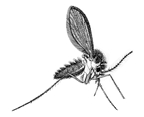Kala-azar

Kala-azar (kalajar) an infectious disease caused by an intracellular flagellate protozoan Leishmania donovani, common in rural parts of the tropical and subtropical countries of the world. The disease, also known as visceral leishmaniasis, is characterized by lesions of the reticulo-endothelial system, especially the liver and spleen, and is often fatal. Children are more susceptible to this disease. Kala-azar is transmitted to man by the bite of the infected female Phlebotomus sandfly. The incubation period is generally 2 to 6 months.
Kala-azar has been a public health problem in the Bengal moribund delta region since the early eighteenth century. It obtained an epidemic form in the late 18th and early 19th centuries. Due to Kala-azar, Burdwan and some other districts of West Bengal were losing population. Many people deserted the Kala-azar afflicted areas and move to East Bengal.
The problem became a serious threat in late 19th century due to construction of railways and consequent deterioration in the natural drainage system.
As a collateral effect of DDT spraying under the Malaria Eradication Programme (MEP), incidence of Kala-azar in Bangladesh almost disappeared at one point, because of high susceptibility of the vector sandfly to DDT. However, the disease showed resurgence in the late 70's. Following are the data on recent Kala-azar cases collected by the Directorate of Health Services:
Kala-azar cases
| Year | Number | Death |
| 1994 | 3967 | 9 |
| 1995 | 4214 | 19 |
| 1996 | 6813 | 30 |
| 1997 | 8846 | 17 |
| 1998 | 7152 | 28 |
| 1999 | 5856 | 7 |
| 2000 | 8600 | - |
| 2001 | 5980 | - |
| 2002 | 8136 | - |
| 2003 | 5960 | - |
| 2004 | 9000 | - |
| 2005 | 6924 | - |
| 2006 | 7250 | - |
Source M&PDC section under Directorate of General Health Services.
Most of these cases were reported from greater Mymensingh, Rangpur, Rajshahi, and Comilla districts. Cases of Kala-azar were also detected in Dhaka, Jhenaidaha, Patuakhali and Narayanganj districts.
According to a study conducted by the Institute of Epidemiology, Disease Control and Research (IEDCR), the disease is spreading at an alarming rate. Ten years ago, the disease was confined to some northern districts only. It has now spread to more than 30 districts. Compared to the number of patients identified and treated, most Kala-azar patients remain undetected and untreated.
The protozoan parasite gets multiplied in the bone marrow, spleen and liver. It attacks lymph nodes or the body defence system, crippling the production of anti-bodies. This leads to unusual enlargement of the liver and spleen. Kala-azar also causes pneumonia, diarrhoea, loss of weight and appetite, discomfort in the abdomen, and often nasal and gum bleeding that may lead to death. Although there are several methods of detecting the Kala-azar parasite, the most reliable one is the direct agglutination test (DAT). The test is very expensive and in Bangladesh only five laboratories including one each at Pabna and Dinajpur have facilities for conducting it.
Phlebotomus argentipes is the recognized vector of Kala-azar in the eastern part of this subcontinent. A WHO report indicates that Kala-azar is a serious public health problem in the state of Bihar and West Bengal in India. After its resurgence in some parts of Bihar in the early seventies, the disease spread to 36 districts in Bihar, and 10 districts in West Bengal. There were 17,806 cases with 72 deaths till 1986, which rose to 77,102 cases with 1,419 deaths in 1992 in Bihar and West Bengal; at least 17,429 people were attacked and 255 of them died of the disease in 1997.
The sandfly breeds in soil with sufficient moisture and organic debris. It is found in cracks and crevices of dwellings and floors of cattle sheds. The larva takes about 20 days to 1.5 months to reach the adult stage depending upon temperature and availability of food. The female sandfly takes the blood of mammals. It can not fly but hops, is nocturnal in habit, and rests in humid, dark areas. High humidity favours the fly. Adult longevity is about two to four weeks depending upon prevailing environmental conditions.
There are no regular Kala-azar vector control activities in Bangladesh. Areas with large number of cases and outbreaks are sometimes sprayed with DDT as the vector sandfly is still found susceptible to DDT. In some areas insecticide-treated bed nets have been tried to control Kala-azar and have been found effective. Elimination of breeding grounds of flies is helpful in reducing incidence of Kala-azar. WHO currently supports Bangladesh's programme to control the incidence of this disease. It includes: (i) indoor residual insecticidal spray twice annually to interrupt transmission of the parasite, (ii) early diagnosis and complete treatment of Kala-azar cases; and (iii) health education to create community awareness. Sodium Stiboglucona, an intra-muscular injection pushed every 20 days, has proved to be very effective in treating Kala-azar. [SM Humayun Kabir]
